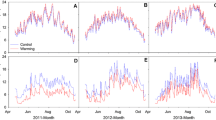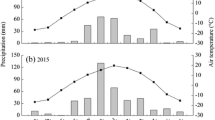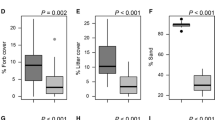Abstract
Carbon and water exchanges between vegetated land surfaces and the atmosphere reveal the ecosystem-scale water-use efficiency (WUE) of primary production. We examined the interacting influence of dominant plant functional groups (C3 and C4) and land-use history on WUEs of annual corn and perennial (restored prairie, switchgrass and smooth brome grass) grasslands in the US Midwest from 2010 through 2013. To this end, we determined ecosystem-level (eWUE) and intrinsic (iWUE) WUEs using eddy covariance and plant carbon isotope ratios, respectively. Corn, switchgrass, and restored prairie were each planted on lands previously managed as grasslands under the USDA Conservation Reserve Program (CRP), or as corn/soybean rotation under conventional agriculture (AGR), while a field of smooth brome grass remained in CRP management. The iWUEs of individual C3 plant species varied little across years. Corn had the highest (4.1) and smooth brome grass the lowest (2.3) overall eWUEs (g C kg−1 H2O) over the 4 years. Corn and switchgrass did not consistently show a significant difference in seasonal eWUE between former CRP and AGR lands, whereas restored prairie had significantly higher seasonal eWUE on former AGR than on former CRP land due to a greater shift from C3 to C4 species on the former AGR land following a drought in 2012. Thus, differences in grassland eWUE were largely determined by the relative dominance of C3 and C4 species within the plant communities. In this humid temperate climate with common short-term and occasional long-term droughts, it is likely that mixed grasslands will become increasingly dominated by C4 grasses over time, with higher yields and eWUE than C3 plants. These results inform models of the interaction between carbon and water cycles in grassland ecosystems under current and future climate and management scenarios.





Similar content being viewed by others
References
Abraha M, Chen J, Chu H, Zenone T, John R, Su Y-J, Hamilton SK, Robertson GP. 2015. Evapotranspiration of annual and perennial biofuel crops in a variable climate. Global Change Biol Bioenergy. doi:10.1111/gcbb.12239.
Albert DA. 1995. Regional landscape ecosystems of Michigan, Minnesota and Wisconsin: a working map and classification. General Technical Report NC-178. St. Paul, MN: U.S. Department of Agriculture, Forest Service, North Central Forest Experiment Station. http://www.nrs.fs.fed.us/pubs/242. Accessed Feb 2016.
Allison SK. 2008. Differences in the effect of drought upon restored and remnant prairies (Illinois). Ecol Restor 26:95–7.
Baldocchi DD. 2003. Assessing the eddy covariance technique for evaluating carbon dioxide exchange rates of ecosystems: past, present and future. Glob Chang Biol 9:479–92.
Baldocchi D, Falge E, Gu L, Olson R, Hollinger D, Running S, Anthoni P, Bernhofer C, Davis K, Evans R, Fuentes J, Goldstein A, Katul G, Law B, Lee X, Malhi Y, Meyers T, Munger W, Oechel W, Paw KT, Pilegaard K, Schmid HP, Valentini R, Verma S, Vesala T, Wilson K, Wofsy S. 2001. FLUXNET: a tool to study the temporal and spatial variability of ecosystem scale carbon dioxide, water vapor, and energy flux densities. Bull Am Meteorol Soc 82:2415–34.
Beer C, Ciais P, Reichstein M, Baldocchi D, Law BE, Papale D, Soussana J-F, Ammann C, Buchmann N, Frank D, Janssens IA, Knohl A, Köstner B, Moors E, Roupsard O, Verbeeck H, Vesala T, Williams CA, Wohlfahrt T. 2009. Temporal and among-site variability of inherent water use efficiency at the ecosystem level. Glob Biogeochem Cycles 23:1–13.
Burba GG, McDermitt DK, Grelle A, Anderson DJ, Xu LK. 2008. Addressing the influence of instrument surface heat exchange on the measurements of CO2 flux from open-path gas analyzers. Glob Change Biol 14:1854–76.
Camill P, McKone MJ, Sturges ST, Severud WJ, Ellis E, Limmer J, Martin CB, Navratil RT, Purdie AJ, Sandel BS, Talukder S, Trout A. 2004. Community- and ecosystem-level changes in a species-rich tallgrass prairie restoration. Ecol Appl 14:1680–94.
Chapman KA, Brewer R. 2008. Prairie and savanna in southern Lower Michigan: history, classification, ecology. Mich Bot 47:1–48.
Collins SL, Adams DE. 1983. Succession in grasslands: thirty-two years of change in a central Oklahoma tallgrass prairie. Vegetatio 51:181–90.
Deal MW, Xu J, John R, Zenone T, Chen J, Chu H, Jasrotia P, Kahmark K, Bossenbroek J, Mayer C. 2013. Net primary production in three bioenergy crop systems following land conversion. J Plant Ecol. doi:10.1093/jpe/rtt057.
Dong G, Guo J, Chen J, Sun G, Gao S, Hu L, Wang Y. 2011. Effects of spring drought on carbon sequestration, evapotranspiration and water use efficiency in the Songnen meadow steppe in northeast China. Ecohyrology 2:211–24.
Epstein HE, Lauenroth WK, Burke IC, Coffin DP. 1997. Productivity patterns of C3 and C4 functional types in the US Great Plains. Ecology 78:722–31.
Farquhar GD, Sharkey TD. 1982. Stomatal conductance and photosynthesis. Ann Rev Plant Physiol 33:317–45.
Flanagan LB, Farquhar GD. 2014. Variation in the carbon and oxygen isotope composition of plant biomass and its relationship to water-use efficiency at the leaf- and ecosystem-scales in a northern Great Plains grassland. Plant Cell Environ 37:425–38.
Foken T, Wichura B. 1996. Tools for quality assessment of surface based flux measurements. Agric For Meteorol 78:83–105.
Ghannoum O, von Caemmerer S, Conroy JP. 2002. The effect of drought on plant water use efficiency of nine NAD-ME and nine NADP-ME Australian C4 grasses. Funct Plant Biol 29:1337–48.
Grelle A, Lundberg A, Lindroth A, Morén A-S, Cienciala E. 1997. Evaporation components of a boreal forest: variations during the growing season. J Hydrol 197:70–87.
Hamilton SK, Hussain MZ, Bhardwaj AK, Basso B, Robertson GP. 2015. Comparative water use by maize, perennial crops, restored prairie, and poplar trees in the U.S. Midwest. Environ Res. doi:10.1088/1748-9326/10/6/064015.
Hendrickson JR, Schmer MR, Sanderson MA. 2013. Water use efficiency by switchgrass compared to a native grass or a native grass alfalfa mixture. Bioenergy Res 6:746–54.
Hudson BD. 1994. Soil organic matter and available water capacity. J Soil Water Conserv 49:189–94.
Ito A, Inatomi M. 2012. Water-use efficiency of the terrestrial biosphere: a model analysis focusing on interactions between the global carbon and water cycles. J Hydrometeorol. doi:10.1175/JHM-D-10-05034.1.
Keeling CD, Piper SC, Bacastow RB, Wahlen M, Whorf TP, Heimann M, Meijer A. 2001. Exchanges of atmospheric CO2 and 13CO2 with the terrestrial biosphere and oceans from 1978 to 2000. I. Global aspects, SIO Reference Series, No. 01-06, Scripps Institution of Oceanography, San Diego, CA. http://scrippsco2.ucsd.edu/data/in_situ_co2/monthly_mlo.csv. Accessed Mar 2015.
Maseyk K, Hemming D, Angert A, Leavitt SW, Yakir D. 2011. Increase in water-use efficiency and underlying processes in pine forests across a precipitation gradient in the dry Mediterranean region over the past 30 years. Oecologia 167:573–85.
McIntyre S, Lavorel S. 1994. How environmental and disturbance factors influence species composition in temperate Australian grasslands. J Veg Sci 5:373–84.
McMillen RT. 1988. An eddy correlation technique with extended applicability to non-simple terrain. Bound Layer Meteorol 43:231–45.
Michigan State Climatologist’s Office. 2103. Gull Lake (3504) Michigan State University. http://climate.geo.msu.edu/climate_mi/stations/3504/. Accessed Mar 2014
Moncrieff J, Clement R, Finnigan JJ, Meyers T. 2004. Averaging, detrending, and filtering of eddy covariance time series. In: Lee X, Massman W, Law B, Eds. Handbook of micrometeorology: a guide for surface flux measurement and analysis. Dordrecht: Kluwer Acadamic. p 7–32.
Monson RK, Prater MR, Hu J, Burns SP, Sparks JP, Sparks KL, Scott-Denton LE. 2010. Tree species effects on ecosystem water-use efficiency in a high-elevation, subalpine forest. Oecologia 162:491–504.
Moore CJ. 1986. Frequency response corrections for eddy correlation systems. Bound Layer Meteorol 37:17–35.
Osmond CB, Winter K, Ziegler H. 1982. Functional significance of different pathways of CO2 fixation in photosynthesis. In: Erson PA, Zimmerman H, Eds. Encyclopedia of plant physiology, Vol. 12B. New York: Springer. p 479–547.
Parrish DJ, Fike JH. 2005. The biology and agronomy of switchgrass for biofuels. Crit Rev Plant Sci 24:423–59.
Pinheiro J, Bates D, DebRoy S, Sarkar D, R Core Team. 2015. nlme: Linear and Nonlinear Mixed Effects Models. R package version 3.1-120. http://CRAN.R-project.org/package=nlme. Accessed Mar 2015
Ponton S, Flanagan L, Alstad K, Johnson B, Morgenstern K, Klyun N, Black TA, Barr AG. 2006. Comparison of ecosystem water-use efficiency among douglas-fir forest, aspen forest and grassland using eddy covariance and carbon isotope techniques. Glob Change Biol 2:294–310.
R Development Core Team. 2015. R: A language and environment for statistical computing. Vienna: R Foundation for Statistical Computing. ISBN 3-900051-07-0
Reichstein M, Falge E, Baldocchi D, Papale D, Valentini R, Aubinet M, Berbigier P, Bernhofer C, Buchmann N, Gilmaov T, Graier A, Grünwald T, Havránková K, Janous D, Knohl A, Laurela T, Lohila A, Loustau D, Matteucci G, Meyers T, Miglietta F, Ourcival J-M, Rambal S, Rotenberg E, Sanz M, Tenhunen J, Seufert G, Vaccari F, Vesala T, Yakir D. 2005. On the separation of net ecosystem exchange into assimilation and ecosystem respiration: review and improved algorithm. Glob Change Biol 11:1424–39.
Richardson AD, Hollinger DY, Burba GG, Davis KJ, Flanagan LB, Katul GG, Munger JW, Ricciuto DM, Stoy PC, Suyker AE, Verma S, Wofsy C. 2006. A multi-site analysis of random error in tower-based measurements of carbon and energy fluxes. Agric For Meteorol 136:1–18.
Schotanus P, Nieuwstadt FTM, De Bruin HAR. 1983. Temperature measurement with a sonic anemometer and its application to heat and moisture fluxes. Bound Layer Meteorol 26:81–93.
Seibt U, Rajabi A, Griffiths H, Berry JA. 2008. Carbon isotopes and water use efficiency: sense and sensitivity. Oecologia 155:441–54.
Steduto P. 1996. Water use efficiency. In: Pereira LS, Feddes RA, Gilley JR, Lesaffre B, Eds. Sustainability of irrigated agriculture. NATO ASI series E: applied sciences. Dordrecht: Kluwer Academic Publishers. p 193–209.
Suttle KB, Thomsen MA, Power ME. 2007. Species interactions reverse grassland responses to changing climate. Science 315:640–2.
Teeri JA, Stowe LG. 1976. Climatic patterns and the distribution of C4 grasses in North America. Oecologia 23:1–12.
Thoen G. 1990. Soil Survey of Barry County, Michigan (USDA Soil Conservation Service, Michigan Agricultural Experiment Station, and Michigan Technological University, Washington DC).
Tilman D. 1996. Biodiversity: population versus ecosystem stability. Ecology 77:350–63.
Tsialtas JT, Handley LL, Kassioumi MT, Veresoglou DS, Gagianas AA. 2001. Interspecific variation in potential water-use efficiency and its relation to plant species abundance in a water-limited grassland. Funct Ecol 15:605–14.
Wagle P, Kakani VG. 2012. Growing season variability in evapotranspiration, ecosystem water use efficiency, and energy partitioning in switchgrass. Ecohydrology. doi:10.1002/eco.1322.
Webb EK, Pearman GI, Leuning R. 1980. Correction of flux measurements for density effects due to heat and water vapor transfer. Q J R Meteorol Soc 106:85–106.
Werling BP, Dickson TL, Isaacs R, Gaines H, Gratton C, Gross KL, Liere H, Malmstrom CM, Meehan TD, Ruan L, Robertson BA, Robertson GP, Schmidt TM, Schrotenboer AC, Teal TK, Wilson JK, Landis DA. 2014. Perennial grasslands enhance biodiversity and multiple ecosystem services in bioenergy landscapes. Proc Natl Acad Sci 111:1652–7.
Wilczak JM, Oncley SP, Stage SA. 2001. Sonic anemometer tilt correction algorithms. Bound Layer Meteorol 99:127–50.
Wright CK, Wimberly MC. 2013. Recent land use change in the Western Corn Belt threatens grasslands and wetlands. Proc Natl Acad Sci USA 110:4134–9.
Xiao JF, Sun G, Chen J, Chen H, Chen S, Dong G, Gao S, Guo H, Guo J, Han S, Kato T, Li Y, Lin G, Lu W, Ma M, McNulty S, Shao C, Wang X, Xie X, Zhang X, Zhang Z, Zhao B, Zhou G, Zhou J. 2013. Carbon fluxes, evapotranspiration, and water use efficiency of terrestrial ecosystems in China. Agric For Meteorol 182–183:76–90.
Zenone T, Chen J, Deal MW, Wilske B, Jasrotia P, Xu J, Bhardwaj AK, Hamilton SK, Robertson GP. 2011. CO2 fluxes of transitional bioenergy crops: effect of land conversion during the first year of cultivation. Glob Change Biol Bioenergy 3:401–12.
Zhu X, Yu G, Wang Q, Hu Z, Han S, Yan J, Wang Y, Zhao L. 2014. Seasonal dynamics of water use efficiency of typical forest and grassland ecosystems in China. J For Res 19:70–6.
Acknowledgements
This work was supported by the US Department of Energy’s Great Lakes Bioenergy Research Center (DOE Office of Science, DE-FC02-07ER64494 and DOE Office of Energy Efficiency and Renewable Energy, DE-AC05-76RL01830), the US National Science Foundation LTER Program (DEB 1027253), and MSU AgBioResearch. We thank T. Zenone, H. Chu, M. Deal, R. John, J. Xu and K. Kahmark for tower-related works, S. Bohm and S. Sippel for data management and S. Vanderwulp, P. Jasrotia, J. Bronson, and J. Simmons for field-related work. We also thank the subject-matter editor Dr. Peter Groffman and the two anonymous reviewers for their constructive comments.
Author information
Authors and Affiliations
Corresponding author
Additional information
Author Contribution
MA, IG, JC, SKH & GPR designed study, MA & IG analyzed data, MG, IG & SKH wrote draft manuscript with all authors contributing substantially to revisions.
Electronic Supplementary Material
Below is the link to the electronic supplementary material.
Rights and permissions
About this article
Cite this article
Abraha, M., Gelfand, I., Hamilton, S.K. et al. Ecosystem Water-Use Efficiency of Annual Corn and Perennial Grasslands: Contributions from Land-Use History and Species Composition. Ecosystems 19, 1001–1012 (2016). https://doi.org/10.1007/s10021-016-9981-2
Received:
Accepted:
Published:
Issue Date:
DOI: https://doi.org/10.1007/s10021-016-9981-2




